Joy Neal Kidney's Blog, page 51
July 6, 2022
Grandmother Goff Visits the Wilsons at Minburn, Iowa
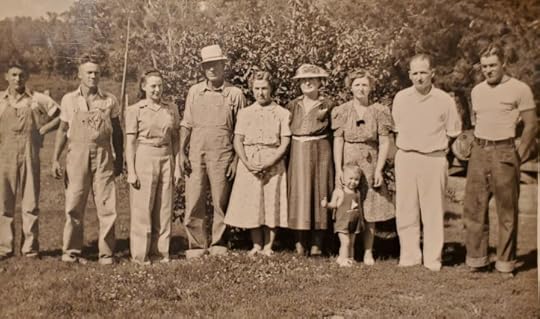 Junior (16th birthday), Danny, Doris, Clabe, and Leora Wilson. Grandmother Laura Goff. Bernadine and J.B. Goff with young Ronnie. Dale Wilson. July 6, 1941, near Minburn, Iowa
Junior (16th birthday), Danny, Doris, Clabe, and Leora Wilson. Grandmother Laura Goff. Bernadine and J.B. Goff with young Ronnie. Dale Wilson. July 6, 1941, near Minburn, IowaGrandmother Laura Goff moved from Dexter to Omaha in 1936 when her son C.Z. (Clarence Zenas) offered a job to his widowed brother J.B. (Jennings Bryan) who lived with Grandmother in Dexter with his children Maxine and Merrill.
The Wilsons had lived in and around Dexter for a decade by then, so Grandmother was surprised when she got a letter in March, 1939, saying they’d moved to a farm near Minburn.
The foreman of a WPA job where Clabe Wilson worked in Dexter said his brother was looking for a tenant farmer for his place near Minburn. Clabe got the job. Sons Delbert, Dale, Danny, and Junior were great help on the farm, earning their own paychecks. Danny had just graduated and Junior still had a year left of high school. This was taken on his 16th birthday.
Doris Wilson was a waitress in Perry, but regularly rode the M & St L (Minneapolis & St. Louis railroad) to the Minburn depot.
J. B. Goff married Bernadine Paxson, who had been Dexter schoolteacher for Danny and Junior when they were in grade school. Ronnie is their son, the step-brother of Maxine (who was married by then) and Merrill (who had joined the Marines). J.B. drove them to Minburn for this visit.
Delbert was still home, so he probably took this delightful photo on July 6, 1941.
Donald Wilson was serving aboard the USS Yorktown (CV-5), on its third Neutrality Patrol in the Atlantic.
July 5, 2022
“I Wish I could Give it Six Stars”
How I appreciate this recent review of Leora’s Letters from Phil Rosenkrantz, the author of Letters from Uncle Dave: The 73-year Journey to Find a Missing-in-Action World War II Paratrooper.
“It is rare to have such a compelling collection of letters as well as the actual context and memories that surrounded them during the war. I wish I could give it six stars. I was able to put myself in the shoes of the family members and imagine what they were going through. It helped me understand what my family went through during the war. I also had an uncle who was missing in action and another uncle who was rescued when his ship was sunk in the Pacific*.
“It is one thing to understand World War II history from a statistical standpoint such as battle details and casualty figures. It is another thing to understand what happened to one family and then multiply that by the loss of thousands of families who experienced similar grief and loss.
“The book is well written. The author does a great job of laying out the family’s thoughts and emotions. Almost everyone living now was affected by World War II in some way–directly or indirectly. I know from experiences that the effects of World War II influenced many family for decades. It is helpful for everyone to understand this aspect of the last century and this book will help you do that.”
*The ship Dr. Rosenkrantz mentioned was the USS Chicago (CA-29), which Delbert and Donald Wilson served on during the 1930s.
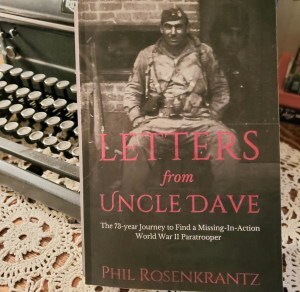 My review of Dr. Rosenkrantz’s book.
My review of Dr. Rosenkrantz’s book.
Letters from Uncle Dave was endorsed by Steve Snyder, author of Shot Down: The True Story of Pilot Howard Snyder and the Crew of the B-17 Susan Ruth. My review of Shot Down.
July 3, 2022
Dexfield Road

I seem to have a lot of history with Dexfield Road, especially if you follow it south far enough when it becomes Maple Street along the west edge of Dexter, Iowa.
The road goes north to Wagon Road (not far, but doesn’t show on the map), which goes west to the ghost towns of Dale and Glendon, east to Redfield.
Beginning halfway between there and the Raccoon River, at what is now 320th Street (just west of the white blob in the upper center). We lived at the top of the hill to the west, where Dad rented the Donald Shaw farm when he was discharged from the USAAF after World War II. I started kindergarten at Redfield while we lived there.
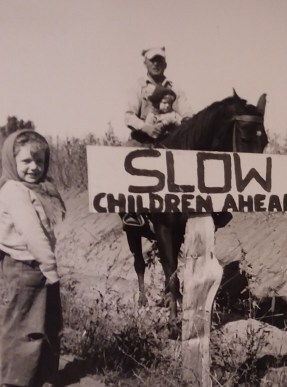 Dad is on the horse with Gloria, while I–one of the SLOW CHILDREN–am posing. Taken along that road, late 1940s.
Dad is on the horse with Gloria, while I–one of the SLOW CHILDREN–am posing. Taken along that road, late 1940s.Remember Bonnie and Clyde? The map notes Dexfield Park, where they had shootout with a posse in 1933. Before it became Dexfield Park, it began as a mineral spring spa called Marshall Springs, named for the distant relative, Pete Marshall, who discovered the spring.
 Robert and Dode Reynolds own the beautiful old Marshall home. They hosted out of us descendants of Miles Marshall, including two from out of state–Malinda Marshall Danziger and her dad, Robert Marshall.
Robert and Dode Reynolds own the beautiful old Marshall home. They hosted out of us descendants of Miles Marshall, including two from out of state–Malinda Marshall Danziger and her dad, Robert Marshall.A little farther south, on the west side of the road, is a house known as the Marshall house. I understand that at least part of his original cabin is part of the home.
Next, on the east side, is the site of the 1948 National Plowing Match, where President Harry Truman gave a major speech for thousands on a very hot day in September. Dad perched me, a four-year-old, on his shoulders so I could see my very first US President.
Go south to White Pole Road (the highway through Dexter) and on the corner is Drew’s Chocolates, which was begun when Helen Drew made her first batches of candy in 1927. It still does business in her basement candy kitchen.
The road becomes Maple Street there. Follow it south across the Rock Island railroad tracks to P48. Southeast of that corner was the old town pump, the one Clabe Wilson kept oiled as a WPA job during the Great Depression.
Keep on going to the cemetery (light green area where the road turns west), the old part of which is west of the road. My mother was part of a Decoration Day ceremony there when she was a girl. (Described in Chapter 9 of Leora’s Dexter Stories: The Scarcity Years of the Great Depression.) Many of my ancestors on Dad’s side are buried there.
The new part is east of the road. There I’ll become part of the seventh generation buried in the Dexter Cemetery, awaiting the final trumpet.
June 29, 2022
Mom’s Famous Potato Salad
Anytime Mom took her potato salad to a potluck, or to her grandson’s high school graduation party, people asked for her recipe. Actually, there are two secret ingredients, or not so secret. The same two that made Doris Neal’s deviled eggs a hit: Miracle Whip (instead of mayonnaise) and candied dill pickles.
Candied dills can be hard to find. To make your own, dissolve 2 3/4 cup of white sugar in 1/3 cup of cider vinegar. Add drained dill pickles and refrigerate about a week.
Doris Neal’s Potato Salad for a Crowd
5 pounds potatoes, cooked, cooled, cut up
8 eggs, hard cooked and peeled
2/3 cup chopped onions
1 jar candied dill pickles, chopped
1/4 cup snipped fresh parsley
1 teaspoon celery seed
2/3 of a large jar of Miracle Whip
paprika
parsley sprigs
Slice some of the eggs and save the best “rounds” for garnish. Chop remaining eggs. Mix with remaining ingredients and spoon into a serving bowl.
Mom also had a signature way to garnish her potato salad, with perfect eggs slices around edge, sprinkled with paprika, and parsley sprigs tucked in. If several potato salads arrived at a potluck, you could always tell which one was hers.

This is the closest I could find to the way Mom decorated her salad, but she arranged the eggs around the edge, with parsley springs, then paprika sprinkled only on the egg rounds.
A poignant story about the importance of the paprika.
Mom grew her own parsley, sharing the abundance with parsley caterpillars that would eventually become Swallowtail butterflies.
June 27, 2022
Heartbreak House, the Kansas City Quartermaster Depot
I transcribed this article in its entirety since I’ve not had much success in digging up information about the Kansas City Quartermaster Depot, even through Kansas City historians. This seems odd since this had to be a a very important place during the war.
The effects of both Dale and Danny Wilson were sent to the KCQM Depot, from their bases in Port Moresby, New Guinea, and Triolo, Italy. Clabe and Leora Wilson started getting letters from them about where their sons’ clothing, watches, billfolds, stationery, and other items should be sent.
 Dale Wilson’s Pidgin English dictionary was among his effects sent home to Iowa through the KCQM Depot.
Dale Wilson’s Pidgin English dictionary was among his effects sent home to Iowa through the KCQM Depot.—–
‘Heartbreak House’ Clears Belonging of Lost Soldiers
KANSAS CITY, MO (AP)–Every week or so, a switch engine shoves a couple of boxcars up to a big, white, 11-story building, once a national mail order house but now the Kansas City quartermaster depot with two floors devoted to the army’s personal effects bureau.
The boxcars bring here, for distribution to relatives, the personal effects of American soldiers who have died or have been killed, captured or listed as missing–the trinkets they treasured, their letters, their money.
Lieut. Col. John R. Murphy, who under Col. C. J. Black, the depot’s commanding officer, has been in charge of the bureau through its two years of existence, says it takes six months to a year–and three entries in the big files–to complete the final record on many soldiers.
Money.
Their money usually arrives first; next may be the billfolds, pictures and letters they had with them when they died; finally comes the articles left in their quarters when they went out to their last battle.
The bureau has had to feel its way along, for it is without a precedent, so far as Colonel Murphy knows.
During the last war, the personal effects were cleared through Hoboken, N. J., and several others points, and difficulties encountered were almost as great as the variety of articles shipped home. This time it was decided to have one distributing point, centrally located.
Next of Kin.
Most cases cause little trouble. The property is received, the next of kin is found, and the effects are sent on by mail, express or freight. (If the package weighs less than four pounds, the post office department carries it free.)
All this would be as cold and as impersonal as death itself if Colonel Murphy didn’t believe this bureau should utilize something more than just another form letter.
As he wrote to a congressman who inquired about the bureau: “A am ever conscious that we here at the bureau are dealing with wives, mothers and fathers who have made, through the loss of their husband or son, a tremendous sacrifice.”
Letters.
Letters to the bureau display a cross section of life. Some of a son’s belongings haven’t arrived yet, so a father demands:
“I want to know what has been done about the property stolen from my son’s footlocker. The government stole half his check, now all his effects. Nothing could be lower than this.”
A mother, who has received her son’s effects, writes:
“I know, dear people, this is merely routine work, ‘your job,’ to you, but it’s very special and wonderful to us. God bless you all.”
And then there are the problems which make filling out an income tax blank seem easy. A fairly common one: A soldier marries; doesn’t tell his mother. To whom shall the effects be sent?
Investigation.
A father writes that he is sure his son had much more money than was returned, and will the army please hurry the rest along immediately.
An investigation discloses that the soldier neglected neither wine, women nor son, that he repeatedly was absent without leave, that the surprising thing is that he had any money left at all. How should this news be broken to the father?
A girl wrote to inquire what had been done with her brother’s belongings. She knew exactly where everything should go, she said, for her brother had written he was sending them. Queer, thought the colonel, how did the fellow know his number was up?
The answer was simple, but shocking. He had gotten into serious trouble, was court-martialed and executed.
The army tactfully reported he had died “not in the line of duty.” The sister never guessed why her brother knew that death was near.
Understanding.
All this means that 7,000 letters, tactful and understanding, go out of here ach week, for the bureau wants this last contact most relatives will have with the army to be sympathetic. “Very little of the glory of war in this business,” declares the colonel.
To all those who fret because personal effects are slow in coming, there is this assurance:
The army wants to deliver these things as quickly as possible; indeed, it has to keep them moving. For this bureau grows as casualty lists grow, and, as the boxcars keep moving in, packages and boxes must go out or even this mammoth storeroom will have more than it can handle.
The Des Moines Tribune, Mar. __, 1944
—–
My earlier post about the KCQM Depot.
June 24, 2022
An Attempt to Locate the Missing B-25 Mitchell
Dale Wilson and five others were on a mission to Wewak/Boram, New Guinea, when they where hit by AA (Anti-Aircraft) fire November 27, 1943.
There has been one serious attempt to locate the lost B-25 Mitchell, but it resulted in a tragedy in 2005 for the main wreck researcher, Don Fetterly. This is the first time I’ve ever shared these details.
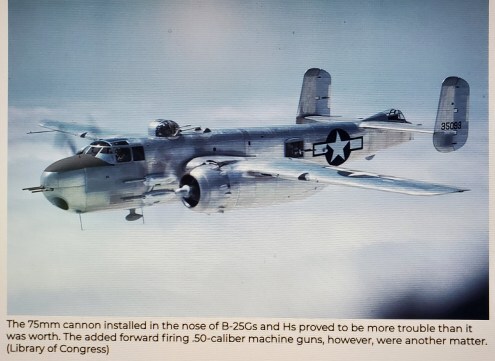
Donald R. Fetterly was an engineer with Raytheon Corp. in Tucson, Arizona, but had a passion for hunting for wrecks in the Australia-New Guinea area. A hobby diver since 1986, he connected with an Australian boat owner. The boat had a side-scan sonar to provide images of the ocean floor.
I was “introduced” to Don in late 2004 by Jim Ragsdale, whose wife is the niece of the bomber’s navigator, John Stack. I met Jim, a reporter and editorial writer for The Star Tribune in the Twin Cities, when we visited our son there in June 2005. I’d already sent information about Dale Wilson, who was the copilot of the missing B-25. He gave me a copy of John Stack’s letters he’d transcribed.
The Wilsons and the Stacks were the only two families, from the six men aboard on that last bombing mission (November 27, 1943), who received messages from the West Coast from people who’d heard radio broadcasts in early 1944 by Tokyo Rose that their sons were Japanese POWs.
Fetterly’s father served during the war and collected books about the war. Don had also researched wrecks in the south Pacific and interviewed men who’d been in combat during the war. His first trip to New Guinea was in late 1989, where he dived a liberty ship in a remote location. Since he did extensive research before attempting a dive, I sent him as much documentation as I’d dug up–maps, photos, casualty reports. Don also gave presentations regularly about his diving expeditions.
Don asked me not to tell anyone that he was planning the Wewak exploratory expedition for October 2005, with a possible main expedition the spring of 2006.
 Photo: Pacific Wrecks
Photo: Pacific WrecksPhotojournalist and documentary filmmaker Ulla Lohmann, from Germany, called to get background information for a documentary about searching for the plane. She was the senior producer. Ulla and Don Fetterly collected tapes of Wewak strikes from the National Archives in February of 2005, to help pinpoint the search location.

The two big questions: Did any of the crew escape, and how did the Japanese get the detailed information they used on Radio Tokyo?
Don Fetterly died October 20, 2005, after suffering a stroke on Rod Pearce’s boat in Papua New Guinea. He’d hired Rod for ten days. After first being hospitalized in New Guinea, he was Medevacked to Cairns Base Hospital in northern Australia. Before he died, he told the others, “Complete the mission,” but the mission was dropped.
The names of the six men lost on this mission are listed, along with more than 36,000 others, on the Tablets of the Missing at the Manila American Cemetery and Memorial, Manila, Philippines.
Journalist Jim Ragsdale died in 2014. Mary Ragsdale, his widow and the niece of navigator John Stack, has taken up his mission to write her uncle’s story.
Five brothers served. Only two came home. Leora’s Letters: The Story of Love and Loss for an Iowa Family During World War II.
June 22, 2022
Small Town Barber (poem)
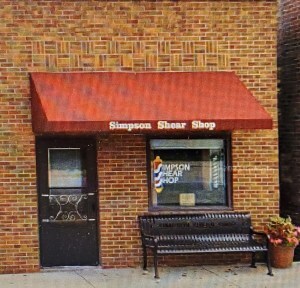
A Dexter treasure,
he stoops from sixty years
of barbering, now
joined by his daughter,
customers in bib overalls,
seedcorn caps, work shoes,
nodding politeness,
with country drawls,
the Simpson Shear Shop
especially busy
when it rains and farmers
cannot get into the field.
June 20, 2022
Clint Knee, notable Perry Lawman, part of Bonnie and Clyde Posse
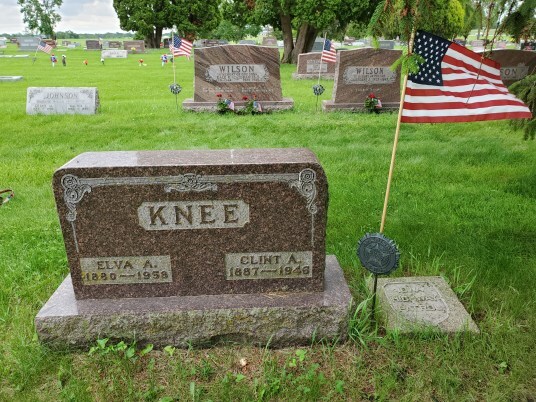 The plaque under the flag says “Iowa State Patrol.” You can see the Wilson family stones just beyond.
The plaque under the flag says “Iowa State Patrol.” You can see the Wilson family stones just beyond.At Perry’s Violet Hill Cemetery, when the women in my family took home-grown flowers to arrange into bouquets for Memorial Day, my mother pointed out the headstone of Clint Knee, one of Iowa’s first state patrolmen.
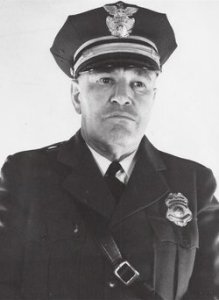 I’ve seen only a few photos of Clint Knee, never smiling, but he had a servant’s heart and was a mentor to at least one man. (See the story with the retirement watch, below.)
I’ve seen only a few photos of Clint Knee, never smiling, but he had a servant’s heart and was a mentor to at least one man. (See the story with the retirement watch, below.)His named came up again when I learned that he was part of the posse during the 1933 shootout in Dexfield Park. But he’s been an elusive man to learn much about, a quiet Iowa hero.
C. A. Knee was born southwest of Perry in Dallas County in 1887 and attended Jamaica country school.
For some time he was a stationary engineer on the Milwaukee Railroad in Perry. Knee served in World War I as a private in a transportation unit in France.
He served on the Perry City Council, and was elected Dallas County Sheriff in 1931. He served five terms and was also elected president of the Iowa Sheriffs’ Association.
As sheriff, Knee was part of the posse that arrested Buck and Blanche Barrow in July 1933, when the Barrow Gang hid out in Dexfield Park near Dexter. During the ensuing shootout, Bonnie, Clyde and their driver escaped.
The Iowa State Patrol was created in 1935, originally composed of 50 men. Knee became one of the early state troopers. He was appointed chief of the Iowa State Patrol in 1939. One of his first actions was to establish the Patrol Special Accident Investigation Unit.
Knee died in 1946 and was buried at Violet Hill Cemetery in Perry alongside his wife, Elva Knee.
 Source: Iowa State Patrol by Scott M. Fisher, clipping from the Jan. 18, 1939, Dallas County News
Source: Iowa State Patrol by Scott M. Fisher, clipping from the Jan. 18, 1939, Dallas County News
From Jeremy Rodman, who found my April 19, 2020 story about Clint Knee in The Perry News: “My wife’s grandfather Richard Shinn of Adel, Iowa inherited C.A. Knee’s gold watch he received for retirement from the State Patrol. The watch is now under our care. Thank you I have wanted to learn more about this Iowa hero.”
I asked how her grandfather knew Mr. Knee, and asked for a photo of the watch.
Answer: “Richard ‘Dick’ Shinn, grandfather of my wife Daisy Hutzell-Rodman, was taken under Chief Knee’s wing and was Richard’s surrogate grandfather. Richard later owned the Shinn Grocery in Adel Iowa. After Richard’s death a few years ago Daisy and I went to his home now in Estes Park, CO where we were allowed to pick a few items to remember grandpa Shinn. I asked about the gold watch as no one wanted it and was allowed to keep it.”
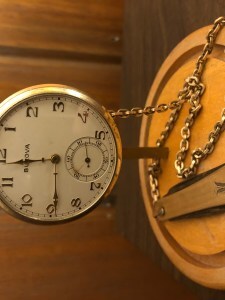
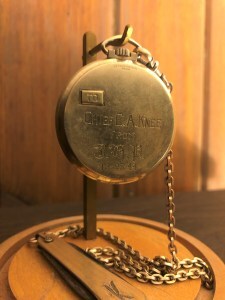
The inscription reads “To Chief C.A. Knee from ISP 12-25-44”
June 15, 2022
Iowa: Smoky Wigwams of the Dusky Savage Warrior
Obituary of an Iowa Pioneer: John Williams (1807-1885)
Uncle John Williams died at his residence in Jackson township, one mile north of Dale, June 15, 1885.
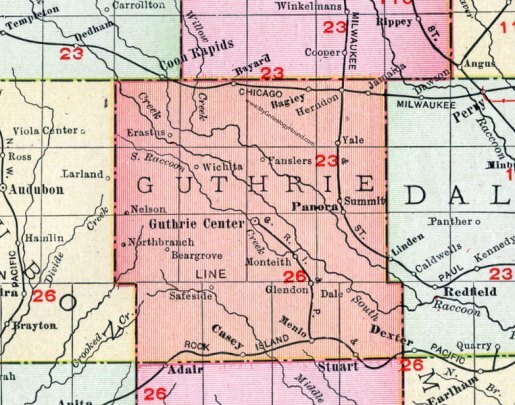 Dale was between Panora and Stuart. The Morrisburg church and cemetery are a little east of Dale. Georgia Williams Wilson’s children, including Clabe, grew up in that area.
Dale was between Panora and Stuart. The Morrisburg church and cemetery are a little east of Dale. Georgia Williams Wilson’s children, including Clabe, grew up in that area.The deceased was born June 26, 1807, in Virginia and had his life been spared 11 days longer he would have been 78 years of age.
He lived in Virginia until 1820 when he moved from there to Guernsey County, Ohio, where he remained in 1854, when he moved to Iowa and has since made his home here. Was married to Harriet Chilcoate in Guernsey County, Ohio in 1828.
Their union was blessed with 14 children, four boys and ten girls. The boys are living three in Iowa and one in Nebraska – of the ten girls, six are living and four have preceded their aged father to a better land. One of the surviving six daughters lives in Nebraska and remaining five are residents of Guthrie County.
The grandchildren living are 61, great grandchildren living 10, and one dead. [Clabe Wilson was one of the great grandchildren.]
Mr. Williams came to Ohio as he did to Iowa, a pioneer, when the wilderness was a mass of howling savage beasts and smoky wigwams of the dusky savage warrior were the only occupants.
First belonged to the Lutheran then the Wesleyan and during his life in Iowa was an active member of the U.B. Church and for many years its class leader at this place.
Children of John and Harriet (Chilcoate) Williams: (* = buried at Morrisburg)
Eliza Ann Williams
*Elizabeth Williams (married James Johnson, no children)
Samuel Williams (married Martha Barr; grandparents of Clabe Wilson)
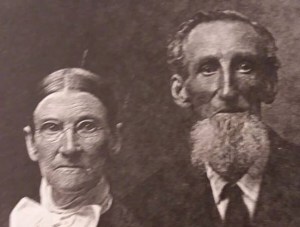 Martha and Samuel Williams
Martha and Samuel Williams*Lucinda Williams (married John Kunkle, no children)
William Ellsworth Williams (married Priscilla Leach, 5 children, ancestor of Della Crowl)
Mary Jane Williams (married Abel Leach, 11 children)
*Rebecca Williams (married Joseph Moore, 9 children)
*Sarah Williams (married Levi Marlenee, 4 children)
*Lewis Williams (married Mary Jane Tuft, 7 children; Civil War, ancestor of J. B. Tiedeman)
Benjamin Williams (married Mary Elizabeth Marlenee, 4 children; m(2) Ann Ellen Williams; Civil War
Charlotte Williams (married John McCool, 13 children; ancestor of Lamonte Kunce)
*Caroline Williams (married Lewis Marlenee, 7 children)
*Ellen Williams (married John McCluen, 3 children; ancestor of Mrs. Hobe Garwood and Helen Keesey)
Adaline Williams (married Alonzo Maulsby, 6 children)
 Morrisburg Cemetery, Guthrie County, Iowa
Morrisburg Cemetery, Guthrie County, IowaThe Guthrie Vedette, June 25, 1885. Also: Lamonte (Williams) Kunce, 1860 Federal Census, Elsie Martinez.
June 13, 2022
“See Jane Run!” by Jolene Stratton Philo

The Novel: In August of 1977, Jane moves out of her parents’ house in Sioux City, Iowa to teach school in Little Missouri, South Dakota. Her mother begs her to come back home when she sees the town of 92 people and hears about the hit-and-run that’s left one of Jane’s new students without a mother. But Jane isn’t letting go of her Mary Tyler Moore style freedom. Just like Mary she’s surrounded by zany characters–from her neighbor Merle Laird and his prize cow Snippy to the glitter-hating school janitor Velma. In such a small town, someone close to Jane is surely the killer.
The Author: Before she became an author, Jolene Stratton Philo taught elementary school for 25 years. Seven of those years were spent in northwestern South Dakota. Their first child was born while we lived there, and our experiences with him resulted in 6 books for the special needs community. Her fiction series, West River Mysteries, draws heavily on her years as an Iowan who landed in cowboy country, who taught country school, and who was adopted and cared for by the locals in the tiny town where she lived.
My thoughts: A plucky young teacher, away from home for the first time, helps solve a who-done-it in small town South Dakota. When a fourteen-year-old student is arrested for murder of another student’s mother, Jane Newell’s problem-solving brain works overtime while she shepherds her class through spelling lessons, hatching monarchs, and glitter projects. With grit, spirit, a great sense of humor and adventure, she also learns to milk a cow and handle a grumpy cleaning lady, all the while pondering clues. The charge against the student is dismissed, and Jane eventually becomes embraced in the arms of this quirky community. I’m looking forward to more West River Mysteries from Jolene Philo.
It also includes the recipe for Merle Laird’s Non-Skid Pancakes!
—–
Here’s a delightful 20-minute interview with Jolene about her books. Toward the end she tells some of the backstories for See Jane Run!



